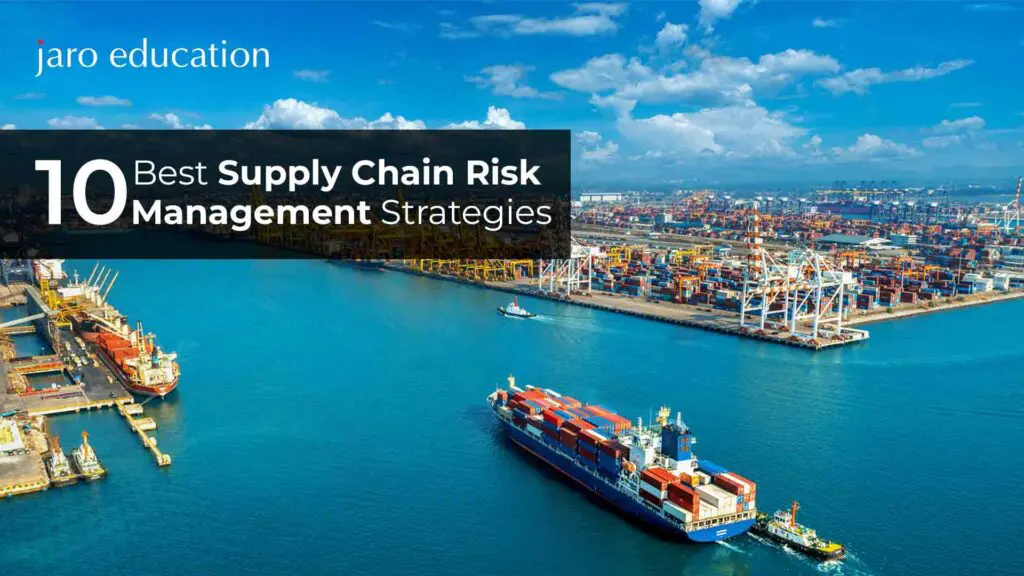
10 Best Supply Chain Risk Management Strategies
In the era of globalisation, businesses face numerous challenges that can disrupt their supply chains, leading to significant financial losses and reputational damage.
The Business Continuity Institute (BCI) reports that 40.2% of COVID-related disruptions originated from Tier 2 suppliers and beyond. This means that disruptions were caused by suppliers deeply associated with the supply chain, often overlooked and inadequately accounted for in risk mitigation plans.
To mitigate these threats and ensure operational resilience, organisations must implement effective supply chain risk management strategies to manage them. Hence, this guide will equip you with the knowledge and tools to fortify your supply chain against potential threats and position your business for long-term success.
Also, you can explore the Executive Post Graduate Certificate Program in General Management by IIM Visakhapatnam. It provides participants with a solid foundation in various functional areas of management, including finance, marketing, operations, strategy, and leadership. The graduates from this course can empower them to excel in their careers and take on leadership roles with confidence and competence.
10 Essential Supply Chain Risk Management Strategies
To ensure smooth operations and avoid potential disruptions, here are the top 10 approaches for supply chain risk management.
#1 Harnessing the Power of the PPRR Risk Management Framework
PPRR represents a four-step approach:
- Prevention: Proactively employ preventive measures to mitigate supply chain risks.
- Preparedness: Establish and execute a comprehensive contingency plan to effectively respond to emergencies.
- Response: Swiftly implement the contingency plan to minimise the impact of disruptive events.
- Recovery: Efficiently restore operations and expedite the return to normal capacity levels.
#2 Leveraging Supply Chain Software for Enhanced Efficiency
While it may not be possible to eliminate environmental risks, such as extreme weather and geophysical events, from your supply chain entirely, proactive planning can significantly mitigate their impact. Supply chain software is pivotal as it offers enhanced visibility, enabling you to identify susceptible supply points and empowering you to reinforce these areas using data-driven insights.
#3 Reducing Environmental Risks
Environmental hazards can significantly impact supply chain operations, causing interruptions, higher costs, and reputational harm. Such risks include climate change, natural catastrophes, and resource scarcity.
Organisations must take proactive steps to reduce these risks. This requires thorough risk analysis, implementing solid sustainable practices, and promoting cooperation with suppliers and stakeholders.
#4 Making Logistics Planning More Effective
The supply chain parts, vulnerable to political, geographical, and economic risks, must be identified. Another important factor is expanding your supplier base because it increases flexibility and decreases dependency on a single provider.
By developing a comprehensive logistics contingency plan, organisations can ensure operational resilience and effectively navigate unforeseen challenges.
#5 Reshoring and Nearshoring
A proven approach to reducing supply chain risk is minimising the scope of the supply chain itself. This can be achieved through reshoring and nearshoring initiatives. Reshoring involves bringing production or manufacturing processes back to the home country. By doing so, companies can enhance control and reduce reliance on distant suppliers, thereby reducing the potential risks of disruption.
On the other hand, nearshoring entails relocating the supply chain closer to the company’s operations by leveraging regional suppliers. Although nearshoring can be costlier, it offers the advantage of shorter supply routes, improved communication, and increased proximity.
#6 Using Large-Scale Data
The emergence of Big Data has revolutionised self-protection capabilities, offering a multitude of opportunities, such as employing predictive analytics to model risk-event scenarios. By harnessing data-driven insights, organisations can forecast potential outcomes during worst-case situations and develop contingency plans that effectively prepare them for potential disasters.
#7 Enhancing Cyber Supply Chain Risk Management
Combatting supply chain online vulnerabilities is crucial as supply chains serve as potential back doors for cyber threats. To address this, implement stringent compliance standards for all third-party vendors, including manufacturers, suppliers, and distributors. Additionally, prioritise comprehensive cybersecurity training for employees to ensure they are well-versed in protocols and best practices.
#8 Optimising Freight Carrier Metrics Tracking
To ensure dependable delivery and streamline supply chain operations, partnering with a reliable freight carrier is essential. Consider the following key metrics when evaluating or re-evaluating freight carriers:
- Measure the time taken for shipments to reach customers after leaving your facility.
- Minimise the number of stops and aim for shorter average stop times to maintain timely deliveries and avoid disruptions.
- Efficient loading processes reduce delays and contribute to overall supply chain efficiency.
- Evaluate carriers’ ability to optimise routes for fuel usage and travel time, which impacts costs and efficiency.
- Look for carriers with consistent maintenance schedules to mitigate breakdowns and prevent supply chain disruptions.
#9 Fostering Risk-Aware Culture
Conducting comprehensive risk awareness training for your workforce is an effective approach. The training should cover key areas such as:
- Identifying common supply chain risks and challenges.
- Implementing risk management best practices.
- Enhancing cybersecurity awareness through computer and internet best practices.
- Providing training on supply chain risk assessment software to encourage user adoption.
#10 Creating Inventory Buffers
While it incurs additional expenses, establishing inventory buffers during new product launches or expansions into different markets presents an opportunity to safeguard against potential disruptions. These buffers act as insurance, mitigating the impact of manufacturing disruptions caused by factors like labour shortages or seasonal weather disruptions.
Takeaway
Implementing effective supply chain risk management strategies is vital for organisations to navigate the complexities and uncertainties of today’s business environment. The 10 best strategies discussed provide a comprehensive framework to proactively identify, assess, and mitigate risks within the supply chain.
To further develop their management skills and gain a competitive edge, professionals can pursue the IIM Visakhapatnam Executive Post Graduate Certificate Program in General Management through Jaro Education’s platform.
The program combines theoretical learning with real-world applications, participants can enhance their career prospects and contribute to the success of their organisations in an ever-evolving global market.

